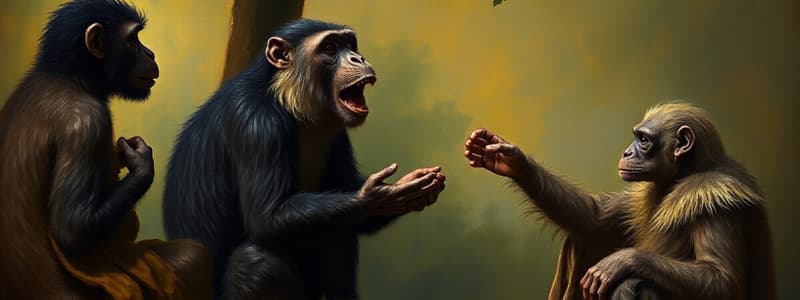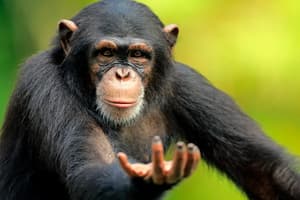Podcast
Questions and Answers
Why is the study of primate communication considered valuable in understanding the evolution of human language?
Why is the study of primate communication considered valuable in understanding the evolution of human language?
- Primates offer insight into pre-human communication abilities. (correct)
- Primate language directly translates to human language.
- Primate communication is more easily studied than human communication.
- Language fossilizes, and primates provide a clear record.
According to the information, what is a key characteristic of human vocal learning that is not as developed in primates?
According to the information, what is a key characteristic of human vocal learning that is not as developed in primates?
- The capacity to use vocalizations for communication.
- The talent for vocally imitating new sounds. (correct)
- The skill to understand vocalizations.
- The ability to produce sounds.
How do primate gestures compare to their vocalizations in terms of flexibility and adaptability?
How do primate gestures compare to their vocalizations in terms of flexibility and adaptability?
- Gestures are much more flexible than vocalizations. (correct)
- Gestures are less flexible and adaptable than vocalizations.
- Gestures and vocalizations have equal flexibility and adaptability.
- Neither gestures nor vocalizations are flexible.
In the context of primate communication, what does 'referential communication' refer to?
In the context of primate communication, what does 'referential communication' refer to?
What was the primary focus of the Edinburgh Zoo chimpanzee study regarding vocal learning?
What was the primary focus of the Edinburgh Zoo chimpanzee study regarding vocal learning?
What evidence suggests that chimpanzees exhibit some level of control over their vocalizations?
What evidence suggests that chimpanzees exhibit some level of control over their vocalizations?
What is the significance of studying 'audience effects' in chimpanzee communication?
What is the significance of studying 'audience effects' in chimpanzee communication?
What is the 'vocal route' concept in the context of language evolution?
What is the 'vocal route' concept in the context of language evolution?
According to the diagram, approximately when did the last common ancestor (LCA) between humans, chimpanzees, and bonobos exist?
According to the diagram, approximately when did the last common ancestor (LCA) between humans, chimpanzees, and bonobos exist?
What does the fake snake study in Uganda suggest about chimpanzee communication?
What does the fake snake study in Uganda suggest about chimpanzee communication?
What does 'syntax' refer to in the context of primate calls?
What does 'syntax' refer to in the context of primate calls?
Based on research mentioned, how do chimpanzees behave when they discover food and are surrounded by friends?
Based on research mentioned, how do chimpanzees behave when they discover food and are surrounded by friends?
What does the term 'gestural route' imply about the origin of language?
What does the term 'gestural route' imply about the origin of language?
In playback experiments studying animal communication, what is the standard procedure?
In playback experiments studying animal communication, what is the standard procedure?
For what purpose were playback studies using vervet monkey alarm calls initially conducted by Seyfarth and Cheney?
For what purpose were playback studies using vervet monkey alarm calls initially conducted by Seyfarth and Cheney?
Which of the following is a potential implication of the bonobo food-call sequences regarding their preferences?
Which of the following is a potential implication of the bonobo food-call sequences regarding their preferences?
According to Hobaiter and Byrne (2014), approxiamtely how many distinct meanings can wild chimpanzees communicate using gestures?
According to Hobaiter and Byrne (2014), approxiamtely how many distinct meanings can wild chimpanzees communicate using gestures?
Why is it believed that humans did not evolve from chimpanzees or bonobos?
Why is it believed that humans did not evolve from chimpanzees or bonobos?
What does the graph of median distance traveled by putty nosed monkeys who hear calls tell us?
What does the graph of median distance traveled by putty nosed monkeys who hear calls tell us?
If an ape performs a 'discrete, mechanically ineffective body movement', what is it doing?
If an ape performs a 'discrete, mechanically ineffective body movement', what is it doing?
What did Whales and Birds vocals cultures tell us about communicative flexibility and vocal learning?
What did Whales and Birds vocals cultures tell us about communicative flexibility and vocal learning?
According to the chart, what does the bipedal stance depict?
According to the chart, what does the bipedal stance depict?
Where were Clay and Zuberbuhler doing their Bonobo research?
Where were Clay and Zuberbuhler doing their Bonobo research?
What does an alarm call to other chimps signal regarding the study in Uganda?
What does an alarm call to other chimps signal regarding the study in Uganda?
Flashcards
Hominids
Hominids
The evolutionary family including orangutans, gorillas, chimpanzees, bonobos, and humans, indicating shared ancestry.
Last Common Ancestor (LCA)
Last Common Ancestor (LCA)
The most recent species from which two different species evolved.
Why study primate communication?
Why study primate communication?
Studying primate communication provides a view into our evolutionary history.
Vocal Route to Language
Vocal Route to Language
Signup and view all the flashcards
Gestural Route to Language
Gestural Route to Language
Signup and view all the flashcards
Vocal Learning
Vocal Learning
Signup and view all the flashcards
Referential Communication
Referential Communication
Signup and view all the flashcards
Playback Experiments
Playback Experiments
Signup and view all the flashcards
Referential Alarm Calls
Referential Alarm Calls
Signup and view all the flashcards
Syntax
Syntax
Signup and view all the flashcards
Audience Effects
Audience Effects
Signup and view all the flashcards
Ape Gesture
Ape Gesture
Signup and view all the flashcards
Ape Gestures
Ape Gestures
Signup and view all the flashcards
Study Notes
- Last common ancestor (LCA) between chimpanzees, bonobos, and humans existed 5-7 million years ago.
- Humans did not evolve from chimpanzees and bonobos; they share a LCA.
Why Study Primate Communication?
- Language doesn't fossilize, so studying primate communication helps understand the roots of language.
- It provides a window into our primate past.
- It helps understand the principle of homology.
How Did Language Evolve?
- Language may have evolved through a vocal route.
- Language may have evolved through a gestural route.
- Language may have evolved through a combination of both vocal and gestural routes.
Communicative Flexibility: Vocal Learning
- Humans are excellent vocal learners and can learn to produce new sounds and vocally imitate.
- Vocal imitation underpins language learning.
- Whales and birds also demonstrate impressive vocal learning abilities, with elaborate vocal cultures and dialects.
Primates and Vocal Learning
- Primates have remarkably limited capacities for vocal learning.
- Gestures can be readily learned and invented.
- Chimpanzees from a zoo in the Netherlands were transferred to join the Edinburgh chimps in 2011, per the Watson et al. (2015) study conducted at the Edinburgh Zoo.
- The study tracked the two groups’ social networks and their food grunts for apples over three years.
- Over three years, the two groups became more integrated, and the Dutch chimps’ food calls became more similar to the Edinburgh ones.
- Chimps may have some control over vocalizations, though there is not much evidence to demonstrate this.
Referential Communication
- Some vocalizations provide meaning about the world, instead of communicating emotions.
- Signals that refer to objects/events in the world are considered an early form of semantic communication.
Playback Experiments
- Playback experiments play sounds to animals to observe their reactions.
- These experiments explore the information that sounds convey to receivers.
Referential Alarm Calls
- Playback studies by Robert Seyfarth & Dorothy Cheney found that Vervet monkeys in Kenya use different alarm calls for different predators.
- "Run for cover!" is used when a leopard is seen.
- "Look up!" is used when an eagle is seen.
- "Scan the grass!" is used when a snake is seen.
The Evolution of Syntax
- The order of linguistic elements influences their meaning.
- For example, the letters ARE, EAR, and ERA have different meanings based on the order.
- The order of calls changing their meaning is currently being explored.
Call Sequences: Basic Form of Syntax?
- Putty-nosed monkeys use "hacks" and "pyows" in call sequences.
- The different call sequences may refer to different predators or travel.
Bonobo Food-Call Sequences
- Bonobos have different food calls, including barks, peeps, peep-yelps, yelps, and grunts, to describe different types of food.
Bonobo Food Call Sequences with Playback Experiments
- Bonobo foraging behavior differs depending on the food call they hear.
- Bonobos respond according to whether they hear a kiwi site or an apple site call.
Audience Effects & Intentionality
- Chimpanzees inform their friends about the presence of food, which demonstrates intentionality.
- Slocombe et al. (2010) found that chimpanzees inform others about food presence and show audience effects.
- Chimpanzees inform each other about potential danger, as demonstrated by a fake snake study in Uganda.
- Crockford et al. (2012) found that chimpanzees inform ignorant group members about danger, which makes them more likely to engage in alarm calls.
Ape Gestures
- A gesture is a discrete, mechanically ineffective body movement used to communicate intentionally to change the behavior of the receiver.
- Ape gestures are more flexible than vocalizations.
More on Ape Gestures
- These gestures are produced flexibly across many contexts.
- Gestures can be learned, modified, and invented.
- Gestures show intentional control.
- Some gestures have specific meanings.
- Wild chimpanzees use 66 gestures to intentionally communicate 19 meanings (Hobaiter & Byrne 2014).
- Graham, et al. (2018) found that Bonobo and chimpanzee gestures overlap extensively in meaning.
Summary
- Aspects of language are deeply rooted in our primate past.
- Studying primates can help estimate our abilities before humans.
- Primate vocalizations can convey meaningful information, which is called referential communication.
- Primates can combine calls into meaningful sequences, which is syntax.
- Primates adjust their calling according to their audience, which is intentional communication.
- Primate vocalizations and gestures offer insights into language evolution.
Studying That Suits You
Use AI to generate personalized quizzes and flashcards to suit your learning preferences.




